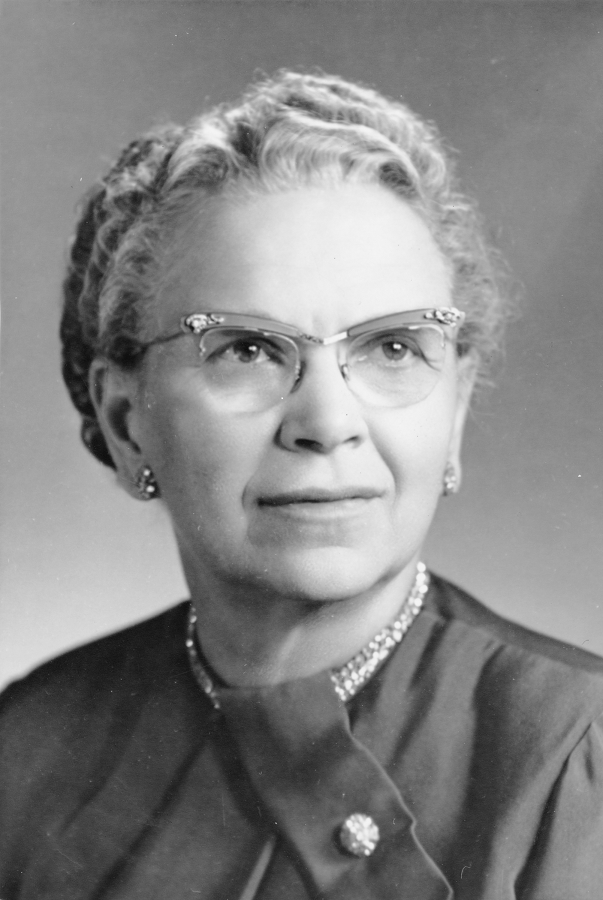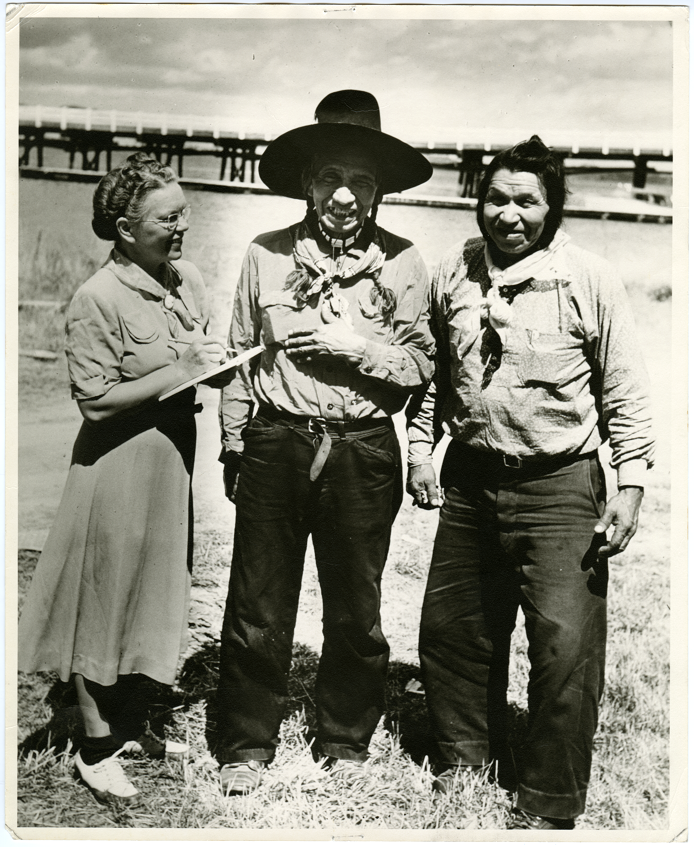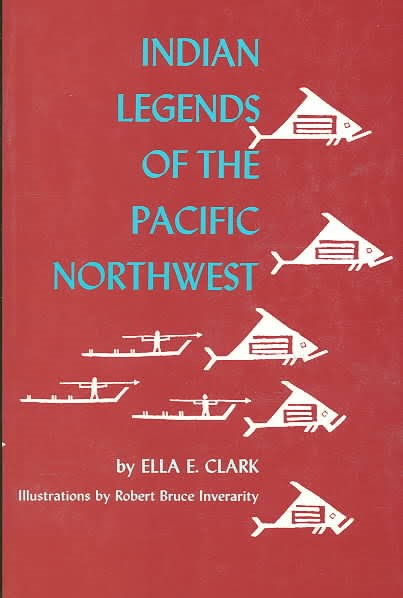Ella E. Clark
by Stefan Krause, 11/25/2016.
Summary
Fascinated with Native American culture, as well as with the geologically active landscape that surrounded her in Washington State, the American teacher and English professor Ella Elizabeth Clark (1896-1984) collected large numbers of indigenous oral traditions and made them available to a large readership. Although not a professional anthropologist or folklorist, Ella Clark devoted her life to the study and dissemination of indigenous oral texts. She collected stories from various sources and traveled through North America to talk to members of different tribes. Her work focused on native stories about landmarks of the northern Rocky Mountains and elsewhere. Her activity as a cultural go-between opened up an archive of land-related knowledge that has been unjustly neglected by scholarship.

Between Teacher and Folklorist
Ella Elizabeth Clark was born in Summertown (Tennessee) on January 8, 1896, and attended high school in Preoria, Illinois. Following the Guide to the Ella Elizabeth Clark Papers 1944-1965, she started working as a high school teacher even before she received her B.A. from Northwestern University in 1921 (“Biographical/ Historical Note”). Between 1917 and 1926 Ella Clark taught English and Drama at different high schools in Illinois before earning her M.A. from Northwestern University in 1927. In the same year she started teaching at the English Department at Washington State University (WSU) in Pullman. According to an interview with Albert Thompson, former Dean of Humanities at WSU, Ella Clark and other high school teachers were brought in to meet the demand of teaching increasing numbers of freshmen in the English Department (38). The university categorized these teachers as ‘associates’, paying them only low wages (38). Most of them did not stay for too long, but Ella Clark proved to be a valuable member of the team. The “Biographical/ Historical Note” mentions that she taught basic and advanced courses in writing and literature, and that her academic focus was on “such diverse subjects as Indian mythology, botany, and firefighting in our national forests.”
Starting in the early 1930s, Clark traveled extensively to foster her research. According to a short biography from the Ella Elizabeth Clark Papers, she traveled through Europe and later made several research trips to western Canada, the Pacific Northwest, Alaska, and the eastern part of the United States (Box 7, Folder 50). Based on the list of “Publications” found in the same folder, it seems that Ella Clark’s early academic interest was on national forests, writing, and descriptions of the local landscape. In 1933 she co-authored A Writer’s Manual and Workbook with Paul P. Kies, and two years later she published the anthology Poetry: An Interpretation of Life. In World War II she worked as a fire lookout for the United States Forest Service in the Cascades Range in the Rocky Mountains for three summers. It was during this time that she got in touch with the majestic volcanoes of the Cascade Range and the local indigenous traditions about the land.[1] In the years after her work as a lookout she went on research trips through North America, interviewed indigenous people, and collected their oral traditions. She published the results of her research in Indian Legends of the Pacific Northwest (1953), Indian Legends of Canada (1960), and Indian Legends from the Northern Rockies (1966). In 1966 she was rewarded for her academic contribution and received the Governor's Writers Day Award.
Ella Clark retired as English Professor at WSU in 1961. Albert Thompson mentions that Clark “would have ill health before she reached retirement here [WSU],” but that she recovered after she had moved to La Jolla in California where “[s]he went out to Lake Alston every day, and spent the rest of her time at her typewriter continuing her creative work on the Indians” (39). For her last project, Sacagawea of the Lewis and Clark Expedition (1983) she collaborated with Margot Edmonds.[2] In the publication process for this volume Clark’s health deteriorated. As Thompson points out, she suffered “a very serious stroke and for months was out of contact with reality” (40). She was sent to a nursing home, and recovered a little. Ella E. Clark died in California at the age of 88 on July 9, 1984.
“Mouthpiece” of Indigenous Storytellers
Ella Clark devoted the majority of her academic career to the study of indigenous oral traditions. This section will focus on her publications on oral stories, since these texts illustrate native memories and reflections on America’s past, and are thus of particular interest to our project. Clark found many of the stories for her books in manuscripts from pioneers, early anthropological studies, or obscure and almost forgotten texts. Yet she also recorded several stories herself by talking to members of native tribes throughout the United States and Canada. Documents from her personal correspondence reveal that Ella Clark wrote to various libraries, schools, museums, and the agencies of Indian reservations to establish contact and ask for texts. The letters also show her main motivation behind her persistent study of indigenous stories. In a letter to the principal of St. Mary’s Mission School in British Columbia from April 5, 1954, Clark writes that it is her hope “that these collections will increase white man’s respect for the Indians and increase the Indians’ respect for their own culture” (Ella Clark Papers, Box 1, Folder 2). In the same document she expresses her “hope to preserve as much as possible of the old folk tales, and to make the most interesting ones available to the general reader.” Indeed, Ella Clark’s books were sold widely and introduced a broad readership to the oral traditions of America’s first people.
Her first collection of indigenous stories, Indian Legends of the Pacific Northwest, was published in 1953. It was probably her most popular book and is still in print more than 60 years after it first came out.[3] According to the introduction in the 1953 edition, Clark selected the stories for the volume based on whether they could be considered as authentic and whether they were interesting (2). Having in mind the general public as readership, Clark altered the language of stories and omitted rather vulgar or brutal passages (e.g. those illustrating Coyote’s unrestrained libido or his interaction with his excrements) to cater to the moral tastes of a 1950s readership. Because of this editing practice her collections of indigenous stories received many negative reviews in academic journals. For example, anthropologist Erna Gunther criticized “the poor choice of stories, their arrangement […], and their complete loss of native literary style” (324). According to Gunther, the stories in the book “all sound alike and have little relation to the vigorous and direct narrative style used by many tribes in this region” (324). Anthropologist Viola E. Garfield passed criticism on the “[u]ncritical use of sources” (924) and referred to those stories in the book that have originally been recorded by missionaries, settlers, and others unfamiliar with native concepts. However, this criticism is rather vague and seems a little harsh considering the fact that the book was purposefully adapted to a readership that consisted of non-specialists and students.[4] Neither Gunther nor Garfield give concrete examples for how the ‘original’ stories would have differed from the ones presented by Clark and they do not fully reflect on the precariousness of the source situation in oral history studies – either the texts were collected by representatives of the colonial power, or they were collected by modern anthropologists, not all of who adhered to the rules of source criticism or were able to verify translations.[5] Other reviewers such as folklorist Geoffrey Turner saw the volume in a more favorable light and described it as a good introduction for folklorists unfamiliar with the Pacific Northwest (312).
Clark’s other collections of native stories had a similar outline and were also designed for the general reader and for teaching purposes. Her attempt to advance public knowledge of indigenous American oral texts has been acknowledged by many people. The famous Canadian ethnographer Marius Barbeau – although criticizing the order and selection of Indian Legends of Canada (1960) – praises Clark for her successful endeavor to be the “mouthpiece” of indigenous storytellers “considering that she is not a professional folklorist” (65). This review reflects the general reception of Clark’s work among professional folklorists and anthropologists. They acknowledged Ella Clark’s effort and the publication of material that had not been printed before, but distanced themselves from the edited content of the stories.
This criticism in anthropological and folkloristic reviews indicates the competition for authority on how to study oral traditions. This competition had its origin in the development of anthropology as an academic discipline. In its early days, anthropology sought for authorization as an exact science. Pioneering anthropologists like Bronislaw Malinowski put extra emphasis on establishing scientific standards for anthropological research.[6] Anthropological writings were expected to meet these standards, which also helped them stand out against other publications. Thus, it is not surprising that renowned scholars like the famous German-American anthropologist Franz Boas reviewed ‘non-anthropological’ collections of oral traditions such as librarian Katharine Berry Judson’s Myths and Legends of the Pacific Northwest (1910) as “entirely misleading so far as they may be intended to give an impression of the true character, scope, and form of Indian mythologies” (254) [7]. However, authors like Judson and later Clark did not pursue a scientific but rather a humanistic agenda and got caught up in anthropology’s search for scientific identity. Ella Clark published her work during a time when anthropological thought was increasingly influenced by the scientific methodology of structuralism. It is also interesting that other citizen scientists collecting oral traditions were almost exclusively female, which raises the questions as to what role gender played in this debate over scholarly precision and empirical value. It seems that female authors like Ella Clark assumed the role of ‘non-native storytellers’ and ‘non-professional story collectors’, whose work was underrated for other reasons than merely the quality of the texts themselves.
In a similar way, many historians criticized Ella Clark’s last monograph, Sacagawea of the Lewis and Clark Expedition (1983) for favoring the theory, held by many indigenous people, that Sacajawea died only in the late nineteenth century, instead of following the more widely accepted version of Sacajawea’s early death in 1812. Clark based her biography of Sacajawea in part on interviews with Shoshone school children who heard stories about the famous woman from their elders. She also published essays that centered on indigenous knowledge of historical events or landmarks (e.g. on the “Bridge of the Gods”) that did not feature prominently in the story archive of anthropologists who were more interested in kinship structures and customs than in topological knowledge. It is one of her greatest achievements that she preserved a corpus of local oral traditions beyond the narrow value definitions of colonial science. Her books make the world of native storytelling more accessible to a greater public and they refer readers to formerly neglected aspects of indigenous traditions.
Oral Traditions as a Window to America’s Deep Past
Throughout her career Ella Clark promoted the dissemination and preservation of indigenous knowledge. She presented the stories of Native Americans and First Nations people as important and credible texts whose voices should not be overheard or dismissed. Ella Clark was convinced that the traditions of the First Americans had to be written down before they would get lost forever. Furthermore, she showed that these texts provided not only enjoyable and educational readings, but contained valuable accounts of events from America’s deep past. Clark’s focus on ‘landmark legends’ rather than the more common stories about tricksters and culture heroes gives a detailed insight into indigenous land-related knowledge.
For our project, oral traditions about historical events such as the Lewis and Clark Expedition or landmarks such as Crater Lake are particularly important. These stories in Ella Clark’s books provide a valuable and necessary counter-archive to academic geological and historical knowledge. Texts from her collections show that the various tribes have preserved memories from events that pre-date the settlement of the Americas by white men. Consequently, these stories not only provide an alternative perspective to past events, but reveal memories from pre-Columbian America. The stories preserved by Ella Clark are today included in online websites operated by indigenous groups.[8]
Ella Clark deserves special credit because she freely devoted her time and her life to the study and dissemination of aboriginal American stories, although she was not a trained folklorist or anthropologist. An early citizen scientist, she recovered and preserved several rare oral traditions and raised awareness for the value of indigenous knowledge among a general readership. She did so at a time when the official scientific attitude was still based on the assumption that indigenous traditions were comparable to Western fairy tales and contained no knowledge related to historical events. Despite her significant editing of the texts and an at times somewhat arbitrary selection of stories (as has been criticized by many professional anthropologists), Clark has published a unique corpus of oral traditions particularly from the American Northwest – that offers an accessible insight into the first Americans’ knowledge of the past.
NOTES
[1] Clark describes how her work as a fire lookout opened the world of the geomythical Pacific Northwest to her in the Introduction (“From Mountain Peaks to Indian Legends”) in her book Indian Legends of the Pacific Northwest (1953).
[2] In 1989, Edmonds published another volume called Voices of the Winds: Native American Legends containing more of her and Clark’s collections of Native American oral traditions.
[3] The University of California Press released a 50th anniversary edition of the book in 2003.
[4] In fact, education publishers such as Glencoe/McGraw-Hill integrated the work of Ella Clark into their textbook Writer's Choice: Grammar and Composition, Grade 9 (2008).
[5] See Ralph Maud’s discussion of Franz Boas’ sometimes problematic methods in collaborating with indigenous translators, e.g. in the case of his collection of Tsimshian myths. Ralph Maud, Transmission Difficulties. Franz Boas and Tsimshian Mythology. Burnaby, BC: Talonbooks, 2000.
[6] One of the most famous outlines of these standards can be found in the introduction of Malinowski’s Argonauts of the Western Pacific (1922).
[7] Then again, Boas has more recently himself been criticized for loose methodology (see Ralph Maud’s book, note 5 above). Boas, who had been born in 1858 in Minden, Germany, and emigrated to the United States in 1886, produced groundbreaking anthropological work and, with the help of native interpreters such as George Hunt and Henry Tate, piled up large collections of texts that are still part of the oral story archives of the tribes he studied.
[8] See, for example, the “Book of Legends,” an online publication of the Confederated Tribes of the Colville Reservation. www.colvilletribes.com/book_of_legends.php.
WORKS CITED
Barbeau, Marius. Review of Indian Legends of Canada, by Ella E. Clark. The Journal of American Folklore 75, 295 (1962). 65-66.
“Biographical/ Historical Note.” Guide to the Ella Elizabeth Clark Papers 1944-1965. Cage 146. Manuscripts, Archives, and Special Collections, Washington State University Libraries, Pullman, WA. n.d. Web. 13 October 2016.
Boas, Franz. Review of Myths and Legends of the Pacific Northwest, by Katharine Berry Judson. The Journal of American Folklore 24, 92 (1911). 254.
Clark, Ella E. Indian Legends of the Pacific Northwest. Berkeley: University of California Press, 1953.
Garfield, Viola E. Review of Indian Legends of the Pacific Northwest, by Ella E. Clark. American Anthropologist. New Series56, 5 (1954). 924.
Gunther, Erna. Review of Indian Legends of the Pacific Northwest, by Ella E. Clark. The Journal of American Folklore 67, 265 (1954). 324.
“Letter to the Principal of St. Mary’s Mission School in Kimberley, British Columbia. April 5, 1954.” Box 1, Folder 2. Cage 146,Ella Elizabeth Clark Papers. Manuscripts, Archives, and Special Collections, Washington State University Libraries, Pullman, WA.
Maud, Ralph. Transmission Difficulties. Franz Boas and Tsimshian Mythology. Burnaby, BC: Talonbooks, 2000.
“Publications.” Box 7, Folder 50. Cage 146,Ella Elizabeth Clark Papers. Manuscripts, Archives, and Special Collections, Washington State University Libraries, Pullman, WA.
Thompson, Albert. “Personal background. Professional career at WSU, 1930-1964, etc.” Interview by James H. Elder. Transcribed June 29, 1987 by Janice Backus. Washington State University Centennial Oral History Project. May 5, 1985.
Turner, Geoffrey. Review of Indian Legends of the Pacific Northwest, by Ella E. Clark. Folklore 66, 2 (1955). 311-312.
“Who’s Who Among Pacific Northwest Authors.” Box 7, Folder 50. Cage 146,Ella Elizabeth Clark Papers. Manuscripts, Archives, and Special Collections, Washington State University Libraries, Pullman, WA.
ILLUSTRATIONS
Figure 1: N.d. “Clark, Ella Elizabeth” [UW 37536]. Portraits Collection, circa 1851-1990s. University of Washington Libraries, Special Collections, Seattle, WA.
Figure 2: N.d. “Ella Clark, two unidentified Indians undated” Oversize [item ID: cg146_oversize_51]. Ella Elizabeth Clark Papers. Manuscripts, Archives, and Special Collections, Washington State University Libraries, Pullman, WA.
Figure 3: Clark, Ella E. Indian Legends of the Pacific Northwest. Berkeley: University of California Press, 1953.


